Hiking and Camping With Dogs
It’s summer, which means it’s the season for adventure! For those of us in Arizona, that may mean hitting the road to find cooler weather for outdoor adventures. Wherever your summer adventures take you, your four-legged friends can come along! All it takes is a little bit of planning and preparation.
We take all three of our medium to large sized dogs on any camping trip we can. If we can do it, so can you.
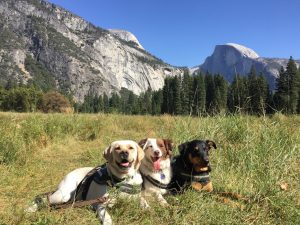
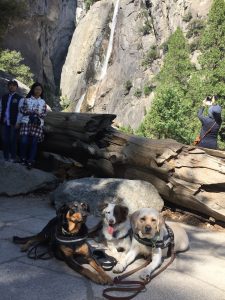
Here are some of my best tips for safe and fun hiking and camping with dogs.
“Take only pictures, and leave only paw-prints.”
Make a visual inventory of your dog’s supplies before leaving. This will help you make sure you have everything your dog will need before hitting the road, and will ensure nothing gets left behind when you pack up to go home. I took three dogs on a three night camping trip in Yosemite valley, and below is pretty much everything we needed to keep them happy and healthy throughout our trip.

Our supply list was as follows:
- water & food bowls
- towels
- a 50 ft line of cord
- dog shoes
- hiking harnesses (and back up harnesses)
- dog food
- coconut oil
- dog toys
- dog chews
- collars
- extra collars
- a long line
- leashes
- several dog hair brushes
- and lots of poop bags
 We usually take my dog’s regular food bowls so it feels more familiar. We also bring things for them to do around the camp site or during the car ride.
We usually take my dog’s regular food bowls so it feels more familiar. We also bring things for them to do around the camp site or during the car ride.
“Check paws and pads often”
A ripped or burned paw pad will put a quick end to hiking fun, which makes taking care of dog paws a big priority. It is a good idea to check your dog’s paws each time you stop for a water break. Pick up each foot and feel between the toes and across the pads. Dogs with more hair between their toes are more likely to get a sticker or debris stuck which can slowly rub a blister. If you are hiking on a muddy trail you will want to rinse and clean the mud from between your dog’s toes. Caked on mud can pull out hair and rub blisters.

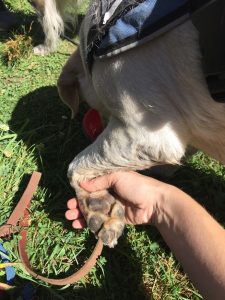 It is a good idea to bring a paw-pad conditioner or something similar like coconut oil to soothe tired paws at the end of the day.
It is a good idea to bring a paw-pad conditioner or something similar like coconut oil to soothe tired paws at the end of the day.
“Never leave home without a flea comb”
A flea comb is ideal for checking your dog over after a hike. This is especially important if you are hiking in a wooded area as ticks are extremely prevalent. A daily check for ticks is a good idea even if your dog is on a flea and tick preventative, because you don’t want your dog bringing ticks into your tent or sleeping bag!
The other big danger is grass awns, also known as foxtails and spear grass. These barbed grass seeds can become stuck and embedded in your dog’s nose, eyes, and skin. Any time your dog is walking in tall grasses it is a good idea to go over them thoroughly to remove grass burrs and awns.
“Get comfy at your campsite”
The very first thing we set up at our campsite was the dog-zip-line. It was easy and cheap to make! All it requires is some corded rope and three carabiner clips. It is also a good idea to bring old towels to wrap the trees in to prevent damage to the tree bark and trunks. Having the dogs on the zip-line allowed them to stretch their legs safely while we set up the rest of camp. Make sure your zip-line is a safe distance from the fire, especially if this is your dog’s first time camping.
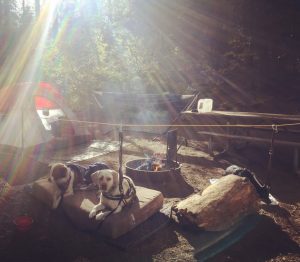 We also brought one of their dog beds from home, and some outdoor blankets for the dogs to lay on. It was pretty chilly while we were in Yosemite, so our pups preferred hanging out near the fire.
We also brought one of their dog beds from home, and some outdoor blankets for the dogs to lay on. It was pretty chilly while we were in Yosemite, so our pups preferred hanging out near the fire.
“Practice makes perfect”
If your dog is more of a weekend warrior than a experienced traveler, it’s a good idea to take it easy on your first camping trip or day of hiking.
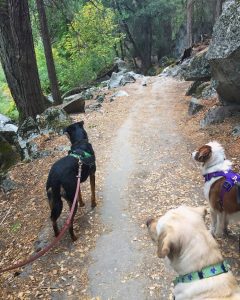
Dogs are tough and want to please you, so they’ll keep hiking long past being tired. The more worn out your dog is the more likely they are to injure themselves or become distressed. We worked our way up to longer hikes by taking practice walks before our trip. We carefully researched which trails our dogs would be allowed on, as well as the length and difficulty of those trails, so we felt confident hiking 4-6 miles each day with our dogs.
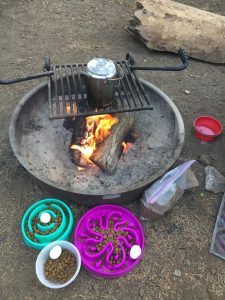 We also added some really fun treats to our dog’s diets during the trip, ensuring they had the protein their muscles would be needing throughout. Our dogs loved getting hard boiled eggs, turkey dogs, and other treats to keep their energy up.
We also added some really fun treats to our dog’s diets during the trip, ensuring they had the protein their muscles would be needing throughout. Our dogs loved getting hard boiled eggs, turkey dogs, and other treats to keep their energy up.
Before our big camping trip we practiced being around the distractions of a campsite with all of our dogs. You can set up the tent in the backyard, go for walks at parks where people barbecue, and practice down stays in grass to get awesome pictures. We also practiced polite trail etiquette, like sitting off trail to let other hikers pass.
We were confident that this trip would be as much fun for our dogs as it would for us.
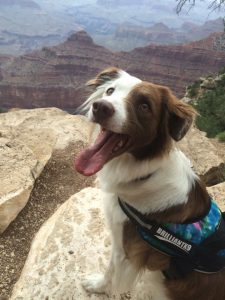
Happy hiking!


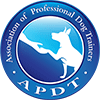

Leave a Reply